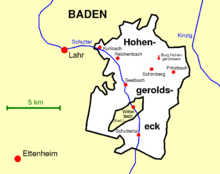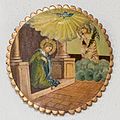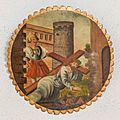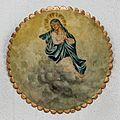St. Antonius (Schuttertal)
St. Antonius is the Roman Catholic parish church of Schuttertal , part of the political community Schuttertal in the Ortenau district of Baden-Württemberg . The parish belongs with the other parishes of the political community Schuttertal, St. Johannes in Dörlinbach and St. Romanus in Schweighausen , to the pastoral care unit Kirche an der Schutter of the Archdiocese of Freiburg , an amalgamation of the former pastoral care units Schuttertal, St. Franziskus and Lahr. The church was designed by the head of the Archbishop's Building Office in Freiburg, Raimund Jeblinger , in a neo-Romanesque style with Art Nouveau elements characteristic of the architect , and was built from 1907 to 1909. Their patron saint is the ancient Egyptian hermit Antonius Eremita . Its history was mainly researched by the Schuttertal teacher and monument conservator Gerhard Finkbeiner (1940–2009).
history
Schuttertal is mentioned for the first time in 1270 in a document in which the Dominican monasteries of Strasbourg and Freiburg im Breisgau delimit their districts from one another: “The brothers from Strasbourg are to get their areas back over the Rhine, namely Lare ( Lahr ) <...> and all of Schutertal (Schuttertal). <...> dealt with in the year of our Lord 1270, in the 13th indiction , the day before the Ides of March (March 14) in Colmar . "In the 13th century belonged to the Schuttertal hohengeroldseck , which is also the right of patronage had , including the right to have a say in the appointment of a clergyman. When it was partitioned in 1277, Schuttertal became part of the upper lordship with Hohengeroldseck Castle as its center and from then on shared its fate, such as belonging to the Electoral Palatinate from 1486 to 1504 and to the Lords of Kronberg from 1634 to 1692. In 1819 it came to the Grand Duchy of Baden .
A "rector ecclesiae" in Schuttertal is mentioned in 1300, but the parish probably goes back to the 11th century when the veneration of St. Anthony began to grow. In the 15th century, people liked to make pilgrimages to St. Antonius in the Schuttertal valley. After the Augsburg Religious Peace of 1555, the legal principle cuius regio, eius religio determined the denominations in the Hohengeroldsecker Lands as well.
- Quirin Gangolf von Geroldseck (1527–1569) introduced the evangelical creed .
- His underage son Jakob (1564–1634) came under the guardianship of Count Karl II of Hohenzollern-Sigmaringen , who re-Catholicized the area.
- Hardly was Jacob of legal age when he appointed Protestant clergy again.
- With the Count von Kronberg following him in 1634, the Catholic faith returned. In a visitation protocol from 1666 it says: “In 1634 the Catholic penance exercises began again in this area because the local residents were Lutherians.” Furthermore: “One should think about how the pilgrimage to St. Anthony could be taken up again ”.
After 1634 Schuttertal did not have its own pastor; The pastor of St. Nikolaus in Seelbach to the north was responsible . In 1735 the relationship was reversed: Seelbach belonged to St. Antonius in Schuttertal. Since 1813 St. Nikolaus has been an independent parish again.
Building history
"Very picturesque in the area, but in a deplorable state of construction", it was said in Schuttertal's building files in 1874 about the previous building. It had an old tower on the entrance side with a gable roof and a pointed arch opening to the single-nave nave. This, with arched windows, came from the 17th century, the choir from the 18th century. The Freiburg conservator Max Wingenroth (1872–1922) wrote in 1908: "Unfortunately, the church is to be demolished, which would be very regrettable because the whole thing, especially the tower, stands better in the landscape than any so-called 'style' building."
A new building had already been discussed at the end of the 18th century. But it only came about under Pastor Karl Nörber (1845–1924), nephew of the Archbishop of Freiburg, Thomas Nörber . On July 8, 1906, it was decided to replace the old one with a new Romanesque “style” church. According to the Archbishop's Building Office, the tower was to have a gable roof again, and after the rubble valleys a pointed roof. “At the stormy request of the community to make the top of the tower richer,” I agreed on a rhombic roof .
- Old views
The old church was demolished in April 1907 and the foundation stone for the new one was laid in June. “The consecration of the foundation stone was carried out on Sunday, June 23, 1907, after the main service with the participation of the church choir and the local music, exactly according to the rules of the ritual. <...> A powerful Te Deum , played by the music and sung by the people, concluded the celebration. <...> At noon the bricklayers, 38 men, mostly Italians, got a meal at the 'Adler'; the 30 stone cutters and stone breakers, mostly Hohenzoller, a meal in the 'Krone'. ”The foundation stone certificate said:“ In the name of allerhl. Trinity with invocation of the all-Holy. Virgin Mary, in 1907 after the birth of our Savior, as Pius X in the 4th year Pope, Wilhelm II. German Emperor, Friedrich Grand Duke of Baden, Dr. Thomas Nörber Archbishop of Freiburg, Dr. Karl Nörber Rev. von Schuttertal and Anton Vögele was mayor of Schuttertal, the foundation stone for this church was ceremonially laid on June 23rd. The church is placed in a special way under the protection of St. Anthony the Hermit, whose intercession may obtain us that the construction proceeds without misfortune and will be completed successfully. "On June 23, 1909, two years after the laying of the foundation stone, the new church was consecrated . It was restored in 1973 and 2007 to 2009.
building
Jeblinger shaped the numerous churches that he planned or helped to plan during his time in Freiburg from 1902 to 1924, the stamp of neo-Romanesque, neo-Gothic or neo- Baroque . The summarizing brackets were the always tangible influences of Art Nouveau.
- Exterior views
The east-facing Schuttertal Church is located on a small hill in the middle of the village immediately north of the cemetery. Red sandstone cuboids determine the richly bodily designed exterior alongside white plastered surfaces. To the whole structure a high running rustication -socket. A round arched portal opens in the facade, covered by a stilted triangular gable with a rising round arch frieze . At the side of the gable there are two arched windows, above the gable a window rosette contributes to the structure. Stair towers on both sides of the facade lead to the organ gallery. The side portals have a high backwork and, like the main portal, triangular gables. The sacristy is located to the south of the drawn-in, polygonal closing choir, to the north the tower with its corner blocks and the "idiosyncratic rhombic roof that gives the valley landscape an unmistakable accent" rises 46 m.
As with Jeblinger's Archbishop's Ordinariate of Freiburg , which was created between 1902 and 1906, this is the formal language of the neo-Romanesque. But Jeblinger let them become “softer, rounder in the sense of Art Nouveau <...>. As in the office building, the attempt is also made here to suppress the abstract graphic profile sharpness of sharp-edged, as it were disembodied surfaces as much as possible and to replace them with corporeal fullness. This is the purpose of a rusticated plinth <...> on the outside of the church that reaches halfway up the outer walls. The side portals, on which the typical motif of the stilted triangular arches or gables reappear, are specially backed with a strong rustical backing for the purpose of greater physicality. "
On each side, eight round arched windows coupled in pairs illuminate the single nave nave, as well as the western rose window, which is filled with a glass painting of St. Cecilia of Rome , surrounded by angels with musical instruments. Each pair of windows is covered inside by a round blind arch. The roof structure of the nave is open, the entire framework, including the roof slope, is visible, the boards are stained brown, the beams are painted. A rounded triumphal arch leads into the choir. Its “Byzantine-looking painting”, executed by Franz Schilling (1879–1964) in 1931, has been whitewashed today, probably since the 1973 renovation.
Furnishing
Altars
Art Nouveau is even more striking in the furnishings than in the architecture.
The furnishing of altars was done by the company “Church Art Workshop Gebrüder Moroder Franz Jof. Simmler ’s Nachf. Offenburg in Baden “, whose most important artist was the sculptor Rudolf Moroder from South Tyrol . Jeblinger had already worked with the Moroder brothers on the parish church of John the Baptist in Forchheim and the church of St. Peter and Paul in Weil am Rhein .
A relief of Antonius Eremita occupies the middle of the high altar retable. On his right side is St. Benedict of Nursia with abbot's staff and chalice with a snake, symbol of a legendary poison attack, on the left, St. Scholastica of Nursia with the dove that Benedict saw flying to heaven when his sister died. Under Benedict a relief shows the collection of manna in the desert ( 2 Mos 16,13-17 EU ), under Scholastica a relief shows the meeting of Abraham with Melchizedek ( Gen 14: 18-19 EU ). The top is a crucifixion group , Jesus between Mary and John . The wide veil boards with dense foliage are gilded.
- Details from the high altar
Angel from the tabernacle
The left side altar is dedicated to the Remembrance Day of Our Lady on Mount Carmel , the so-called Scapular Festival. The enthroned Mary in the middle gives St. Simon Stick , who is kneeling to her left, the scapular , symbol of the religious costume, two small pieces of fabric tied together with ribbons. On the right, St. Mary Magdalene kneels without attribute . Angels hovering over Mary crown her Queen of Heaven.
The right side altar is consecrated to St. Joseph of Nazareth , at whose feet the baby Jesus stands blessing. A carpenter's ax leans to his left. The left side figure shows Saint Aloisius of Gonzaga with a cross and a lily , the right one shows Saint Elisabeth of Thuringia with the flower basket of her rose miracle . Two angels on the left and right above the framing double pillars carry signs with the inscriptions "Ora" and "Labora".
- Side altars
Rosary Secrets
Three times five round tin signs with a diameter of 25 cm, on which three times five rosary secrets are depicted in simple painting, come from the previous church . In prayer, every “secret” is inserted into the Ave Maria with a relative clause after the words:
- Hail Mary, full of grace,
- The Lord is with you.
- You are blessed among women
- and blessed is the fruit of your womb, Jesus ...
- Joyful rosary
- Painful rosary
- Glorious rosary
The last two “secrets” lack a direct biblical basis, rather they are the Roman Catholic dogmas of the bodily acceptance of Mary into heaven and her coronation in heaven .
Others
Above the northern side entrance hangs the high altar picture of the old church, an oil painting from 1670. Saint Anthony is depicted twice, as the Egyptian hermit and as the saint of the Antonite order . As a hermit he crouches, small, on the right in front of his cell and studies a book. As an eponymous saint of the order, he stands tall in the middle, a book in his right hand, his dewstick with a bell in his left hand, a pig at his feet, attributes from the customs of the order, namely the "quest", the regular collection of money with announcement Bells, and the breeding of the "Antonius pigs".
The organ was built by Wilhelm Schwarz & Sohn from Überlingen . In niches under the organ gallery there is a statue of the Heart of the Virgin and a statue of the Heart of Jesus , both made in 1910 by the Marmon art workshop in Sigmaringen .
Appreciation
On the fiftieth anniversary of the consecration of the church, Pastor Wendelin Gihr (1898–1970) said: “Up the valley, visible from afar, the St. Antonius Church presents itself to the beholder like a small cathedral. <...> Architecturally, the outside view forms a varied, extremely relaxed picture, regardless of whether you look at the building from Obertal or from the hill in the west or from Marienplatz. ”According to Finkbeiner, the church speaks the same architectural language, albeit Simplified, like Jeblinger's Archbishop's Ordinariate Freiburg , which was previously built : decorative shapes such as rhombus, chessboard frieze , banding, decorative relief, triangular gable here and there. Also the interior with the open roof structure, with the Byzantine-Neo-Romanesque altars and the Byzantine chandelier was brought to a convincing overall effect. Thanks to Jeblinger, Schuttertal has a stylish religious building, an example of historicism . In general, it is said of Jeblinger that shortly before the outbreak of the First World War he once again created historicizing architecture and was also a master of church furnishings . "Altars, glass painting, ornamental wall and ceiling painting <...> are brought to an atmospheric synthesis, to a total work of art."
literature
- Gerhard Finkbeiner, Hans Scheer: Heimatbuch Schuttertal. Interest group Badischer Ortsippenbücher, Lahr-Dinglingen 1990.
- Gerhard Finkbeiner: The neo-Romanesque church of St. Antonius was built in Schuttertal 100 years ago. A sacred building by the builder Raimund Jeblinger . In: Geroldsecker Land . tape 51 , 2009, p. 20-28 .
- Discover regional studies online Baden-Württemberg: Schuttertal. Digitized. Retrieved on February 6, 2015. Except for the abbreviations, the texts are identical to: Schuttertal. In: Landesarchivdirektion Baden-Württemberg (ed.): The state of Baden-Württemberg. Official description by district and municipality. Volume VI. Freiburg administrative district. Kohlhammer Verlag , Stuttgart 1982. ISBN 3-17-007174-2 , p. 422.
- Werner Scheurer : The Moroder altars of the St. Antonius Church in Schuttertal . In: Geroldsecker Land . tape 51 , 2009, p. 31-38 .
- Pastoral care unit Schuttertal: Parish of St. Antonius Schuttertal. Digitized. Retrieved February 6, 2015.
- Max Wingenroth : Schuttertal . In: Max Wingenroth: The art monuments of the Grand Duchy of Baden. Volume 7: The art monuments of the Offenburg district. Mohr Siebeck Verlag , Tübingen 1908, pp. 135-136. Digitized. Retrieved February 6, 2015.
Web links
Badische Zeitung of October 5, 2009: Photo gallery of the renovated St. Antonius Church in Schuttertal online
Individual evidence
- ↑ Theo Weber: His work is visible to everyone. Mourning for the monument conservator Gerhard Finkbeiner. Badische Zeitung from April 14, 2009. Digitized. Retrieved February 9, 2016.
- ^ Friedrich Facius: Hohengeroldseck. A Black Forest territory in higher politics from 1603 to 1831 . In: Geroldsecker Land . tape 16 , 1974, p. 15-37 . Wittelbach had been in Baden since 1803.
- ↑ Finkbeiner and Scheer 1990, pp: 18-19.
- ↑ Discover regional studies online Baden-Württemberg: Schönberg ; with the story of Hohengeroldseck. Digitized. Retrieved February 8, 2015.
- ^ Ortenau (history, genealogy). Digitized. ( Page no longer available , search in web archives ) Info: The link was automatically marked as defective. Please check the link according to the instructions and then remove this notice. Retrieved November 12, 2016.
- ↑ Finkbeiner and Scheer 1990, p. 221.
- ↑ Finkbeiner and Scheer 1990, p. 237 and Finkbeiner 2009, p: 21.
- ↑ Wingenroth 1908, p. 136.
- ↑ Finkbeiner 2009, p. 22.
- ↑ Finkbeiner 2009, pp. 22-24.
- ↑ a b c Judith Wörner, Hans Jakob Wörner : Raymund Jeblinger (1853–1937): Archbishop's senior building officer and master builder . In: Landesverein Badische Heimat (Ed.): Badische Heimat, Volume 57, Issue 1, pp. 125–136. Freiburg im Breisgau 1977. ISSN 0930-7001 .
- ↑ Finkbeiner and Scheer 1990, p. 342.
- ↑ Finkbeiner and Scheer 1990, p. 243.
- ^ Pastoral care unit Northern Kaiserstuhl: parish church Johannes Baptista in Forchheim. Digitized. Retrieved February 8, 2015.
- ↑ Finkbeiner and Scheer 1990, p. 246.
- ↑ Heinz Finger: The Rosary Prayer and its History ( Memento of the original from March 4, 2016 in the Internet Archive ) Info: The archive link was inserted automatically and has not yet been checked. Please check the original and archive link according to the instructions and then remove this notice. . Contribution to the exhibition "The Holy Rosary" for the year of the Rosary 2003.
- ↑ Adalbert mixed Levski: Broad history of Antoniterordens until the end of the 15th century. (With special consideration of the life and work of Petrus Mitte de Caprariis) (= Bonn Contributions to Church History 8). Böhlau Verlag , Cologne and Vienna 1976, ISBN 3-412-20075-1 , pp. 35-38.
- ↑ Finkbeiner 2009, p: 27.
- ↑ Finkbeiner 2009, pp: 25-26.
Coordinates: 48 ° 16 ′ 7.9 " N , 7 ° 57 ′ 26.4" E







































